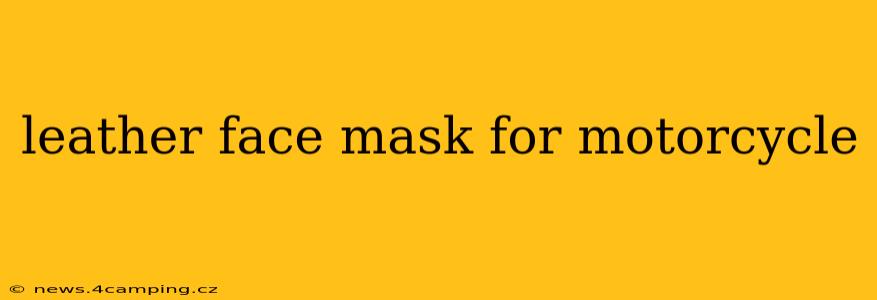Leather face masks have become increasingly popular among motorcycle riders, offering a unique blend of protection and style. But choosing the right one requires understanding the different types, benefits, and considerations. This guide will delve into everything you need to know about leather face masks for motorcycles, answering frequently asked questions and providing expert advice.
What are the benefits of wearing a leather face mask while riding a motorcycle?
Leather face masks offer several advantages for motorcyclists. Primarily, they provide protection from the elements. Wind, dust, debris, and even insects can be significantly reduced by a well-fitted leather mask. This improves rider comfort and reduces eye irritation, especially during long rides. Furthermore, some leather masks offer enhanced protection against cold weather, acting as a barrier against the wind chill. Beyond functionality, leather masks can also add a touch of rugged style and individuality to a rider's gear.
What are the different types of leather face masks available for motorcycle riders?
The market offers various styles of leather motorcycle face masks, each with its own features:
- Full-face masks: These completely cover the face, offering maximum protection from the elements. They often feature eye protection integrated into the design.
- Half-face masks: These cover the lower half of the face, protecting the mouth, nose, and chin. They provide less protection than full-face masks but offer better breathability.
- Bandana-style masks: These are simpler designs, often offering just basic protection from wind and dust. They are usually less protective than full-face or half-face masks.
The type of leather used also plays a role. Full-grain leather is generally the most durable and protective, while other types might offer a softer feel but potentially less durability.
Are leather face masks suitable for all types of motorcycle riding?
While leather face masks offer benefits, they are not suitable for all riding conditions or styles. For high-speed riding or in extremely cold conditions, a full-face helmet is crucial. Leather masks should be considered supplementary protection, not a replacement for proper safety gear. Additionally, visibility can be impacted, especially with darker-colored masks. Riders should prioritize visibility by wearing lighter-colored masks or adding reflective elements.
How do I choose the right size and fit for my leather face mask?
Choosing the right size and fit is paramount for comfort and protection. A poorly fitting mask can restrict breathing or shift during riding, compromising safety and comfort. Many manufacturers provide size charts; consult these carefully before purchasing. Consider trying the mask on before purchase if possible to ensure a proper fit. A snug but not overly tight fit is ideal.
How do I clean and maintain my leather face mask?
Proper cleaning and maintenance will prolong the lifespan of your leather face mask. Regularly wipe down the mask with a damp cloth to remove dust and dirt. For more thorough cleaning, use a leather cleaner and conditioner as directed by the manufacturer. Avoid harsh chemicals or abrasive cleaners that can damage the leather. Proper storage in a cool, dry place will also help maintain its condition.
What are some safety considerations when wearing a leather face mask while riding a motorcycle?
- Never replace a helmet with a leather face mask. A helmet is essential safety equipment for all motorcycle riders.
- Ensure proper visibility. Consider the color and add reflective elements if necessary.
- Maintain a secure fit. A loose or ill-fitting mask can be a distraction or even a safety hazard.
- Be aware of potential breathing restrictions. Certain styles of masks might impact breathing, especially during strenuous activity.
By understanding these factors, you can choose and utilize a leather face mask effectively, enhancing both your riding experience and protection. Remember that safety always comes first. While leather face masks can add a stylish element to your riding gear, they are supplementary and shouldn’t replace essential safety equipment like a helmet. Always prioritize safe riding practices.
